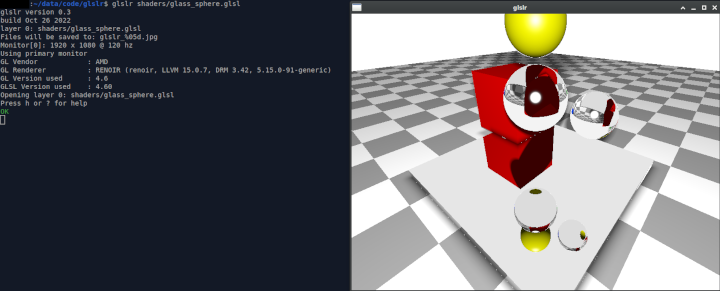- Ultra-lightweight GLSL livecoding framework for Linux and Mac OS X.
- Enables quick fragment shader development in your favorite editor.
- Changes in the fragment shader are compiled in realtime.
- Uniform variables can be filled with data received from a socket.
- Enables GLSL code-reuse across projects with support of #include.
- Has experimental Video4Linux support.
- Has support for livestreaming from a Sony AS30 ActionCam.
- Can save frames to .jpg or .tga.
On Ubuntu:
apt-get install git libgles2-mesa-dev libglfw3-dev libcurl4-openssl-dev libjpeg8-dev
git clone https://github.com/gnd/glslr
cd glslr
make
sudo make install
On Mac OSX:
(get CodeX, homebrew)
brew install glfw3 glew libjpeg
git clone https://github.com/gnd/glslr
cd glslr
make
sudo make install
Please note that you can edit the src/makefile to enable/disable v4l2 support, simply by changing VIDEO=yes or VIDEO=no before compilation. V4l2 support is disabled when compiing on Mac OSX.
This will read the fragment shader from shaders/tunnel.glsl and render it in a 800x600 window on the primary monitor. Any changes you make to the file while glslr is running, will be automatically recompiled and sent to the GPU on save:
glslr shaders/tunnel.glsl
This will read the fragment shader from shaders/template.glsl and render it into a 1024x768 window on the primary monitor:
glslr --primary-res 1024x768 shaders/template.glsl
This will read the fragment shader and render it fullscreen on the secondary monitor (if any):
glslr --secondary-fs shaders/glass_sphere.glsl
For other options see bellow:
usage: glslr [options] <layer0.glsl> [layer1.glsl] [layer2.glsl] ...
options:
window properties:
--primary-fs create a fullscreen window on primary monitor
--primary-res [WidthxHeight] create a width x height window on primary monitor (default: 800x600)
--secondary-fs create a fullscreen window on secondary monitor
--secondary-res [WidthxHeight] create a width x height window on secondary monitor
offscreen format:
--RGB888
--RGBA8888 (default)
--RGB565
--RGBA4444
interpolation mode:
--nearestneighbor (default)
--bilinear
wrap mode:
--wrap-clamp_to_edge
--wrap-repeat (default)
--wrap-mirror_repeat
backbuffer:
--backbuffer enable backbuffer (default:OFF)
network:
--net enable network (default:OFF)
--tcp enable TCP (default:UDP)
--port [port] listen on port (default:6666)
--params [n] number of net input params (default:0)
sony:
--sony enable Sony ActionCAM AS30 support
video:
--vdev [device number] v4l2 device number (default: 0 eg. /dev/video0)
saving:
--save-tga use TGA format instead of the default JPEG
--save-dir [dir] directory where to save frames
--save-file [filename] filename to save frames in the form: name_%0nd
%0nd stands for number of digits, eg. my_%06d
will be saved as my_000001.jpg, my_000002.jpg, etc.. (or .tga)
glslr --net --port [port] --params N example.glsl
The parameters must be sent via UDP to the [port] in the form: "param0 param1 param2 ... paramN;".
A reference is to use PureData's object [netsend]. Currently only integer and float variables are supported.
glslr makes the received data available in the shader as uniform float. The data can be accessed if you declare pamaters like this in the shader:
uniform float m0;
..
uniform float mN;
You can use the parameters to carry input from a MIDI controller, sound-analysis or anything you like. The maximum count of parameters is 99 for now.
glslr makes it possible to use experimental live video input from a V4L device. Currently only YUV422 devices are supported. The image is raw YUV422 - conversion into RGBA is up to you in the shader.
glslr --vdev [video device number] example.glsl
Provide the video device number to be able to use it in the shader. Default is 0 which expands to /dev/video0.
Eg. if you want to use /dev/video1 do:
glslr --vdev 1 shaders/test_video.glsl
In the shader you can access the video data by using uniform sampler2D variable called video. To start camera press 'v'.
#version 130
out vec4 PixelColor;
uniform vec2 resolution;
uniform sampler2D video;
// press 'v' to start video
void main(void) {
vec2 p = vec2( gl_FragCoord.x / resolution.x, 1.0 - gl_FragCoord.y / resolution.y);
PixelColor = texture(video, p);
}
glslr makes it possible to use live video input from a Sony AS30 ActionCam.
glslr --sony shaders/test_sony.glsl
In the shader you can access the video data by using uniform sampler2D variable called sony:
#version 130
out vec4 PixelColor;
uniform vec2 resolution;
uniform sampler2D sony;
void main(void) {
vec2 p = vec2( gl_FragCoord.x / resolution.x, 1.0 - gl_FragCoord.y / resolution.y);
PixelColor = texture(sony, p);
}
glslr provides support to include GLSL files from within the shader. Lines containing the string //#include file will be replaced with the contents of the file:
function.glsl:
color = vec3(1.,0.,0.);
project.glsl:
void main(void) {
vec3 color = vec3(0.,1.,0.);
//#include function.glsl
// ^^^ this line will be replaced with contents of the function.glsl file
gl_FragColor = vec4(color, 1.0);
}
glslr is a fork of pijockey-sound (https://github.com/gnd/pijockey-sound), a GLSL livecoding framework for RaspberryPi, an extension of the original sourcecode of PiJockey by sharrow.
glslr was ported to x86, using GLFW. The Video4Linux capability was scrambled from glutcam by George Koharchik.
glslr is being occasionally developed (when preparing for a new performance) by gnd ♥ gnd.sk.
